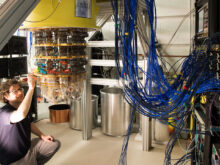Your guide star to innovation
2019 Federal budget invests $1.7 billion for Canada-wide high-speed internet access by 2030
 In its 2019 Federal Budget, Justin Trudeau’s Liberal government is pledging an investment of up to $1.7 billion CAD over 13 years to provide all Canadians with high-speed internet, bridging the digital divide between rural and urban communities. The goal is for 100 percent of homes to have access to at least 50Mbps download and 10Mbps upload speeds by 2030. The money will first be used to establish a Universal Broadband Fund in 2019/20 that will focus on extending network backbones to underserved communities. From the $1.7 billion, the federal government will contribute to the ‘Connect to Innovate’ program, announced in 2016 to acquire low-latency Low Earth Orbit satellite capacity, beginning in Spring 2019.
In its 2019 Federal Budget, Justin Trudeau’s Liberal government is pledging an investment of up to $1.7 billion CAD over 13 years to provide all Canadians with high-speed internet, bridging the digital divide between rural and urban communities. The goal is for 100 percent of homes to have access to at least 50Mbps download and 10Mbps upload speeds by 2030. The money will first be used to establish a Universal Broadband Fund in 2019/20 that will focus on extending network backbones to underserved communities. From the $1.7 billion, the federal government will contribute to the ‘Connect to Innovate’ program, announced in 2016 to acquire low-latency Low Earth Orbit satellite capacity, beginning in Spring 2019.
https://mobilesyrup.com/2019/03/19/budget-2019-internet-rural-communities/
Xplornet invests $500 million over 5 years to deploy 5G internet in rural Canada
 New Brunswick-based telecom provider Xplornet says it will invest over $500 million over the next five years to deliver 5G wireless services to Canadians. Aided by the federal government’s Accelerated Investment Incentive, Xplornet plans to offer 50 and, eventually, 100 Mbps speeds to rural Canadians by late 2020.
New Brunswick-based telecom provider Xplornet says it will invest over $500 million over the next five years to deliver 5G wireless services to Canadians. Aided by the federal government’s Accelerated Investment Incentive, Xplornet plans to offer 50 and, eventually, 100 Mbps speeds to rural Canadians by late 2020.
https://mobilesyrup.com/2019/03/15/xplornet-5g-500-million-rural-internet/
University of Toronto receives $100-million gift for artificial intelligence and biomedicine complex

Rendering shows the University of Toronto’s planning 750,00-square-foot complex at the northeast corner of College St. and Queen’s Park. The school says the building will house the Vector Institute for Artifical Intelligence and the new Schwartz-Reisman Institute for Technology and Society. (Rendering by Weiss/Manfredi).
The University of Toronto has received its largest-ever donation, $100-million CAD, to further the school’s research in artificial intelligence and biomedicine. The donation from the Gerald Schwartz and Heather Reisman Foundation will in part go to a new 750,000-square-foot complex, which will begin construction next fall at the northeast corner of College St. and Queen’s Park in Toronto. The funds will help to maintain Canada’s global leadership in AI research.
Google Builds Cryogenic Circuit to Solve One of Quantum Computing’s Biggest Problems

Google engineer Amit Vainsencher examines his company’s quantum computer system. Even with only half the needed connections attached, there’s a crowd of cables feeding into the 72-qubit quantum processor. (Photo: Google)
A major limitation of current quantum computers is that while their superconducting qubits are housed within a cryogenic enclosure at a temperature of less than 1 kelvin, all their control and readout circuits must remain at room temperature. For today’s sub-100-qubit systems, there is enough space for specialized RF cabling to come in and out of the enclosure. However, to scale up to million-qubit systems, there just isn’t enough room.
To overcome this, a team of researchers at Google, the University of Massachusetts at Amherst, and the University of California Santa Barbara have built a key control circuit that functions at cryogenic temperatures. Now, quantum computers’ circuits can be housed entirely within their cryogenic enclosures, simplifying their design.
Scientists discover a metamaterial shape that blocks all sound

The mathematically designed, 3D-printed acoustic metamaterial is shaped in such a way that it sends incoming sounds back to where they came from. (Photo: Cydney Scott/Boston University)
A team of Boston University researchers recently stuck a small, 3D-printed ring of metamaterial into one end of a PVC pipe and a loudspeaker into the other. When they played music through the speaker, the ring cut 94% of its sound, making it inaudible to the human ear. This ring, printed from an “acoustic meta-material,” is a mathematically modeled design shaped in such a way that it can catch certain frequencies passing through the air and reflect them back toward their source. The discovery has implications for architecture, interior and industrial design. This metamaterial could be used to build soundproof yet transparent walls or be fitted to HVAC systems, drones and MRI machines to make them silent.
https://www.fastcompany.com/90316833/scientists-have-discovered-a-shape-that-blocks-all-sound-even-your-co-workers

